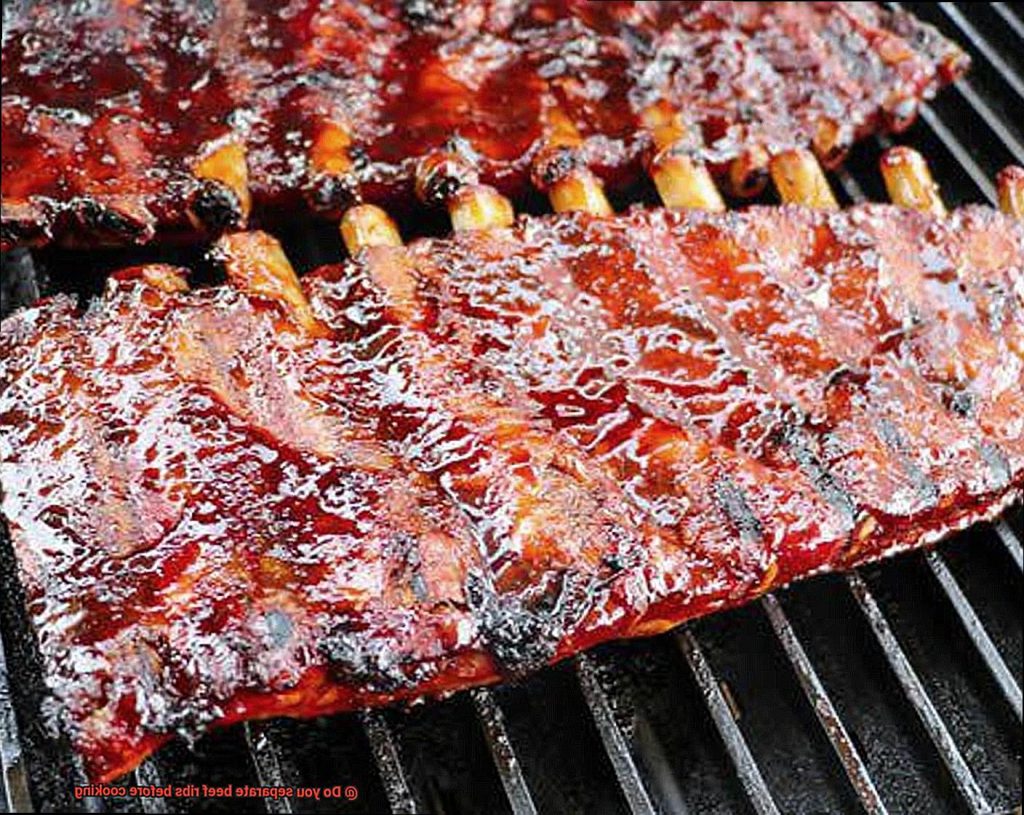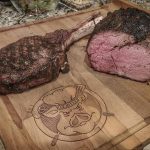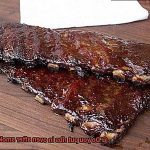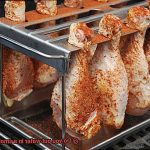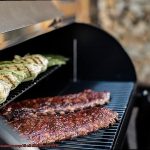Are you a meat lover who can’t resist the juicy goodness of a succulent beef rib? If so, then you’re in for a treat. Today, we’ll be exploring the age-old question: Do you separate beef ribs before cooking?
While some barbecue enthusiasts swear by keeping their beef ribs intact, others argue that separating them beforehand can lead to even more flavor. So which is it?
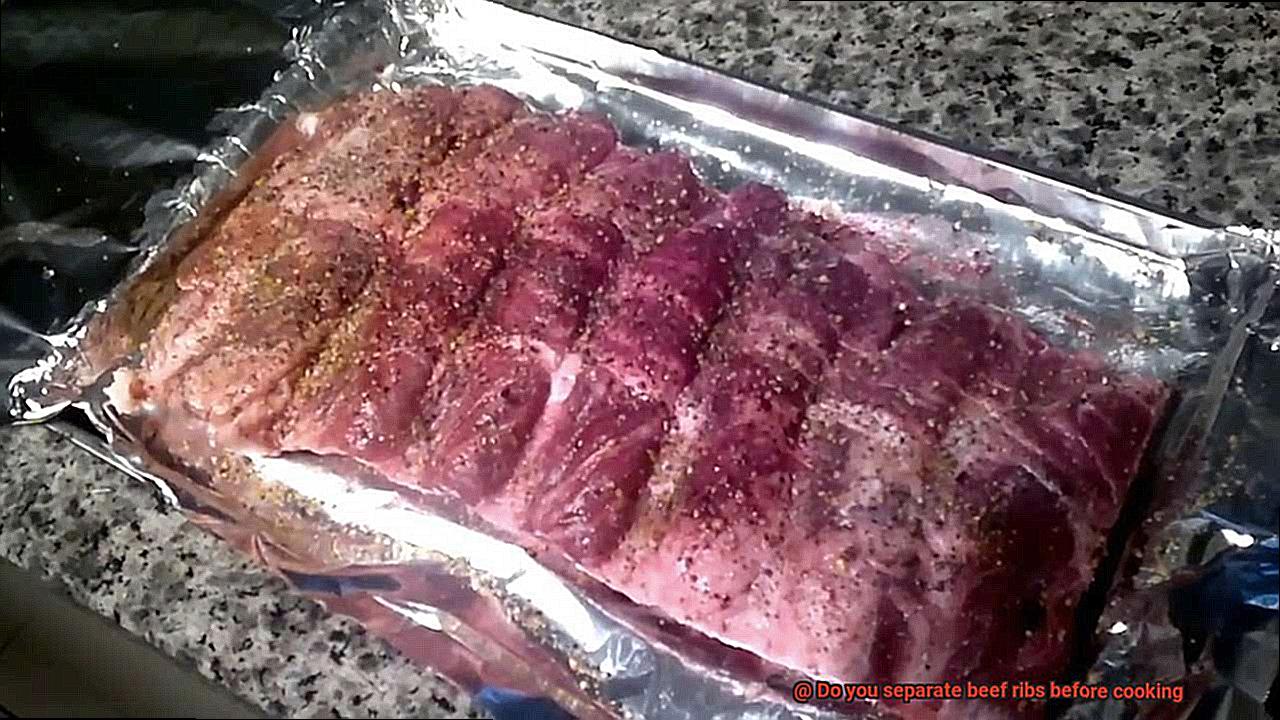
In this blog post, we’ll delve into the pros and cons of separating your beef ribs before cooking. From the science behind the cooking process to tips on presentation, we’ve got you covered. We’ll also share key factors to consider when aiming for that perfect bite.
Whether you’re a seasoned pitmaster or simply someone looking to impress your dinner guests, knowing whether to separate your beef ribs can make all the difference in creating an unforgettable meal. So get ready to learn everything you need to know about cooking beef ribs like a pro.
Contents
What Type of Ribs Should You Separate?
Well, the answer is not as simple as a yes or no. It all depends on the type of ribs you’re dealing with and your cooking method.
First, let’s talk about short ribs. These meaty cuts come from the cow’s plate or chuck section and are perfect for slow cooking methods like braising or smoking. Short ribs have a higher fat content and more connective tissue, making them ideal for low and slow cooking. Leaving them in their slab form allows the fat to render and the connective tissue to break down, resulting in tender meat. However, if you plan to grill or broil your short ribs, separating them into individual bones can help ensure even cooking.
On the other hand, back ribs come from the cow’s rib section and are smaller and leaner than short ribs. They have a more delicate texture and are great for quicker cooking methods such as grilling or broiling. Back ribs can be cooked either as individual bones or in a small rack form. If you’re grilling or smoking your back ribs, leaving them in a rack can help protect the meat from drying out and ensure even cooking.
So, when deciding whether to separate your beef ribs before cooking, consider the type of rib and your preferred cooking method. Here’s a summary:
For short ribs:
- Leave them in their slab form for slow cooking methods like braising or smoking.
- Separate them into individual bones for quicker cooking methods like grilling or broiling.
For back ribs:
- It’s not necessary to separate them before cooking unless you prefer to cook them individually.
- You can also leave them in a small rack form for grilling or smoking.
What Cooking Method Should You Use?
First up, we have grilling. Grilling is a popular option for those looking to achieve a crispy, charred exterior on their beef ribs. Simply seasoning them with your favorite dry rub or marinade and cooking them over high heat for about 20-30 minutes per side can produce delicious results. However, one disadvantage of grilling is that it can be challenging to control the temperature, leading to uneven cooking.
Next, there’s smoking. This slow-cooking method involves using wood chips to infuse the meat with a smoky flavor. Though it can take several hours, smoking can produce tender, juicy beef ribs that fall off the bone. The downside is that smoking requires specialized equipment such as a smoker or grill with a smoking attachment.
If you’re looking for a straightforward and easy method, then baking might be the way to go. This involves seasoning the beef ribs and placing them in a baking dish with some liquid such as broth or beer. After covering the dish with foil, bake it in the oven at 300°F for about 2.5 to 3 hours or until the meat is tender.
Finally, braising involves cooking the beef ribs in a liquid such as broth or wine on low heat for several hours. This method is ideal for tougher cuts of meat that need slow cooking to become tender. Braising can result in flavorful and tender beef ribs, but it also requires close attention to prevent the meat from becoming dry.
Benefits of Separating the Ribs
Then it’s time to consider separating your ribs before cooking. As an expert on this topic, let me walk you through the benefits of doing so.
Firstly, separating beef ribs ensures that each piece is cooked evenly. When left as a whole rack, the meat in the center may not cook as thoroughly as the meat on the outside. By separating each rib, you can guarantee that every piece is cooked to perfection without any under or overcooking. Plus, it’s easier to check for doneness when each rib is separate.
In addition to even cooking, separating beef ribs allows for better seasoning and flavor absorption. With more surface area exposed, each individual rib can absorb more of the delicious rubs and marinades you apply. This results in a mouth-watering end product that will leave everyone impressed.
Furthermore, separating beef ribs makes them much easier to handle and serve. Let’s be honest, whole racks of beef ribs can be unwieldy and difficult to maneuver, especially for those who are not experienced in handling them. Separating the ribs into individual pieces makes them more manageable and easier to serve, making your grilling experience much more enjoyable.
Lastly, separating beef ribs before cooking helps reduce cooking time. Whole racks of beef ribs take longer to cook all the way through compared to individual pieces. By separating them, they will cook faster and more evenly, reducing your overall cooking time. This means more time spent savoring your meal with family and friends.
Benefits of Keeping the Ribs Together
Well, let me tell you as an expert in beef ribs, there are many benefits to keeping the ribs together while cooking.
Firstly, keeping the ribs together helps to maintain moisture. The secret to juicy and tender meat is locking in the moisture. Separating the ribs can cause them to dry out, leading to an unpleasant texture and flavor. By keeping them together, the meat stays moist and tender, allowing it to cook evenly, resulting in a better texture and flavor.
Secondly, keeping the ribs together also helps to protect them from burning. Direct heat from the grill can quickly char the meat, which nobody wants. By keeping them together, the ribs act as a natural barrier against direct heat, preventing burning and ensuring a more even cook and a better final product.
But that’s not all. Keeping the ribs together makes them easier to handle on the grill. No more losing or sticking individual rib portions on a hot grill. Keeping them together makes it easier to flip and move them without any mishaps, making your grilling experience a breeze.
Lastly, keeping the ribs together creates an impressive presentation when serving them. A full rack of beef ribs is a sight to behold and can make for an excellent centerpiece at any BBQ or gathering. Your guests will be impressed by your grilling skills and appreciate the effort you put into presenting such a beautiful dish.
Tips for Separating Beef Ribs
Don’t worry, we’ve got you covered. Separating beef ribs can make all the difference in achieving tender, flavorful meat. Here are some tips to help you become a pro at separating beef ribs.
Tip #1: Sharpen Your Knife
A sharp knife is essential for separating beef ribs. A dull knife will make the job harder and may result in uneven cuts. Ensure your knife is long enough to cut through the thickness of the rib bones.
Tip #2: Remove the Tough Membrane
The membrane on the back of the ribs can be tough and chewy, so it’s crucial to remove it before cooking. Use a butter knife to loosen one corner of the membrane, then grip it with a paper towel and pull it off.
Tip #3: Cut Like a Pro
When cutting the beef ribs, make sure to cut between the bones rather than through them. This will help keep the meat intact and make it easier to handle. A precise cut will yield evenly cooked and tender meat.
Tip #4: Trim Excess Fat for Better Results
Trimming any excess fat from the beef ribs can help prevent flare-ups on the grill and allow for better seasoning penetration. Plus, it will give you a healthier meal without compromising on flavor.
Tip #5: Practice Makes Perfect
Separating beef ribs can take some practice, so don’t be discouraged if it takes a few tries to get it right. With time and experience, you’ll become a pro at separating beef ribs like a boss. Go ahead and perfect your technique.
How to Cook Beef Ribs After Separation
Beef ribs are a classic and hearty dish that many people enjoy. However, when it comes to cooking beef ribs after separation, there are a few things to keep in mind to ensure that they turn out perfectly. Here are five subtopics to help guide you through the process.
Trimming Excess Fat
Before you start cooking your beef ribs, it’s important to trim off any excess fat or gristle from the meat. This will help them cook evenly and prevent them from becoming tough or chewy. However, be careful not to remove too much fat as this can lead to dry meat.
Seasoning
Seasoning your beef ribs is an essential step in ensuring they are flavorful and delicious. After trimming excess fat, apply your desired spices or marinade to the meat and let them sit for at least 30 minutes. This allows the flavors to penetrate the meat fully.
Cooking Methods
There are several cooking methods you can use when preparing separated beef ribs, including grilling, smoking, and braising. Each method has its unique benefits and produces delicious results.
If you choose to grill your beef ribs, ensure that your grill is hot and well-oiled before placing the ribs on it bone-side down. Cook for approximately 10-15 minutes per side or until they reach your desired level of doneness.
For smoking, prepare your smoker according to the manufacturer’s instructions and smoke the beef ribs at low temperature (225-250°F) for several hours until they are tender and flavorful.
Alternatively, if you prefer to braise your beef ribs, you can do so in a slow cooker or Dutch oven. Add the separated ribs along with any desired seasonings or sauces and cook on low heat for several hours until they are tender and falling off the bone.
Resting Time
After cooking your separated beef ribs, it’s crucial to let them rest for a few minutes before serving. This allows the juices to redistribute throughout the meat, resulting in a more tender and flavorful final product.
Personal Preference
Ultimately, whether or not to separate your beef ribs before cooking comes down to personal preference and the type of meat cut you are using. Experiment with different methods and find what works best for you and your taste preferences.
Techniques for Keeping the Ribs Together During Cooking
There are a few techniques you can use to keep your ribs intact and impress your guests with perfectly cooked meat. Let’s explore these methods in more detail.
First up, we have the classic butcher’s twine or kitchen string. This is a go-to option for those who want to keep their ribs together without investing in any specialized equipment. Simply tie the string tightly around the ribs at regular intervals to keep them from falling apart while cooking. Be cautious not to tie them too tightly, as this can affect the cooking process and lead to unevenly cooked meat.
Next, we have the rib rack – a specialized tool designed specifically for cooking ribs. This game-changing piece of equipment holds your ribs in place and prevents them from slipping or falling apart during cooking. All you have to do is place the ribs in the rack and then place it on the grill or in the oven. This technique allows heat to circulate evenly around the meat, leading to tender and juicy results.
Lastly, some people prefer to use aluminum foil to keep their ribs together during cooking. This method involves wrapping the ribs tightly in foil before placing them on the grill or in the oven. While this technique can be effective, it can also impact the texture of your ribs and make them less crispy. Use this method with caution and only as a last resort.
No matter which technique you choose, it’s crucial to monitor your ribs closely while they cook. Overcooking can lead to dry meat, so use a meat thermometer to check for doneness and remove them from heat once they reach the desired temperature.
MV3mJRLSNRQ” >
Conclusion
In summary, the decision to separate beef ribs before cooking is a matter of personal preference and depends on the type of rib and cooking method. For slow-cooking methods like braising or smoking, short ribs are best left in their slab form while back ribs can be cooked individually or in a small rack form. Grilling, smoking, baking, and braising are all effective methods for cooking beef ribs after separation.
Separating beef ribs before cooking offers several benefits such as even cooking, better seasoning and flavor absorption, ease of handling and serving, and reduced cooking time. However, keeping the ribs together has its advantages too – it helps maintain moisture, protects them from burning, makes them easier to handle on the grill, and creates an impressive presentation when serving.
To separate beef ribs successfully, sharpen your knife first and remove the tough membrane. Cut between the bones rather than through them for better results. To keep the ribs together during cooking, use butcher’s twine or kitchen string or try using a rib rack or aluminum foil.
Ultimately, experimenting with different methods will help you find what works best for you.

